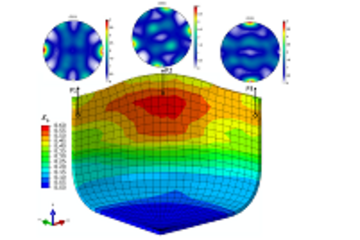All genres
461.
Talk
The Scanning Kelvin Probe as a New Technique to Analyze Buried Interfaces. 196th meeting of the ECS, Honolulu, USA (1999)
462.
Talk
Role of ammonia sulfate particles in the corrosion of electronic devices. Eurocorr'99, Aachen, Germany (1999)
463.
Talk
Versagen von Beschichtungssystemen auf Metallen aufgrund von korrosiver Belastung. GUS Diskussionstage "Feuchtklimasicherheit elektronischer Schaltungen", Gesellschaft für Umweltsimulation e.V. (GUS), München, Germany (1998)
464.
Talk
Einsatz der Rastersondenmikroskopie in der Korrosionsforschung - Neue Ansätze bei der Optimierung von Beschichtungsmethoden. DI-Workshop "Einsatz neuer Mikroskopietechniken in der Metallindustrie", Saarbrücken, Germany (1998)
465.
Talk
Nanoskopische Aspekte der Modifizierung von Metalloberflächen durch Thiol. GfKORR-Arbeitskreis "Grundlagenforschung“, DECHEMA, Frankfurt, Germany (1998)
466.
Talk
New ways for corrosion protection by organic surface modification. 191st Meeting of the ECS, Montreal, Canada (1997)
467.
Talk
Zum Einfluß des Elektrodenpotentials auf die Selbstorganisation von Thiolen auf Gold. Seminar, Max-Planck-Institute for Polymer research (Prof. Knoll), Mainz, Germany (1997)
468.
Talk
On the influence of the electrode potential on growth and stability of thiol monolayer films: Scanning tunneling microscopic and electrochemical investigations. 3rd Indo-German Symposium on modern methods in electrochemistry, Bangalore, India (1996)
469.
Talk
Zum Einfluß des Elektrodenpotentials auf Wachstum und Zerstörung von Thiolfilmen. Bunsentagung, Jena, Germany (1996)
470.
Talk
Organic monolayers as adhesive agents for organic coatings in corrosion protection. Seminar at Dep. Of Chemistry (Prof. R. Crooks), Texas A&M Univ., College Station, TX, USA (1995)
471.
Talk
The influence of the electrode potential on the self-assembly of decanethiol on the Au(111) surface. 188th Meeting of the ECS, Chicago, IL, USA (1995)
472.
Talk
Adsorption selbst-organisierter Mercaptan-Monolagen auf Gold. Workshop on Development and Industrial Application of Scanning Probe Microscopes SXM1, Münster, Germany (1994)
473.
Poster
Role of Trigger Signal Spreading Velocity on Self-healing Capability of Intelligent Coatings for Corrosion Protection. Scientific Advisory Board Meeting 2019, 6-years Evaluation of the Max-Planck-Institut für Eisenforschung GmbH, Düsseldorf, Germany (2019)
474.
Poster
New Insights on the Mechanism of Cathodic Driven Coating Delamination: Suppressed Cation Migration along Zn/Polymer Interface in CO2 Containing Atmosphere. Gordon Research Conferences 2018, New London, NH, USA (2018)
475.
Poster
Corrosion protection by composite coatings containing conducting polymer particles: elucidation of the “protection zone”. Joint Eurocorr 2017 & 20th ICC congress, Prague, Czech Republic (2017)
476.
Poster
Investigation of the role of protection zone around conducting polymer in composite coatings in inhibiting delamination process. Gordon Research Conferences 2016, New London, NH, USA (2016)
477.
Poster
Investigation of the role of protection zone around conducting polymer in composite coatings in inhibiting delamination process. Gordon Research Seminars 2016, New London, NH, USA (2016)
478.
Poster
Conducting polymer based anticorrosion composite coatings with full-scale self-healing ability on zinc and galvanized steel. Gordon Research Conferences 2016, New London, NH, USA (2016)
479.
Poster
Conducting polymer based anticorrosion composite coatings with full-scale self-healing ability on zinc and galvanized steel. Gordon Research Seminars 2016, New London, NH, USA (2016)
480.
Poster
Characterization of electrochemical double layer formed on Au (111) electrode: a KPM, FTIR and APXPS investigation. 2nd Annual APXPS Workshop, Berkeley, CA, USA (2015)











